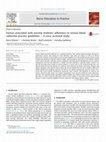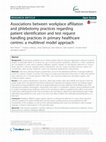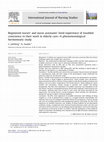Papers by Christina Juthberg

Nordic Journal of Nursing Research, 2022
Low mood and depression are common mental states among older people, and are difficult to diagnos... more Low mood and depression are common mental states among older people, and are difficult to diagnose and treat, causing suffering and declining functions. The aim of the study was to describe registered nurses’ experiences of barriers in providing care for older persons with low mood in Swedish municipal settings. Ten registered nurses working in municipal settings were interviewed using a qualitative approach. The analysis resulted in two main categories, ‘Professional barriers in the care of older persons with low mood’ and ‘Organisational barriers in the care of older persons with low mood’, and four subcategories. Improvements regarding increased knowledge about the use of assessments tools are suggested. Registered nurses should strive to listen to the older person's desires and needs. Furthermore, suggestions about improved collaboration within the organisation as well as with other caregivers in order to provide quality care to older persons with low mood, are made. COREQ w...
Gerontologist, 2014
Staffing, skill mix, quality of care and resident outcomes in swedish residential aged care
Senior Nursing Students’ Reflection on Deviations from Guideline Adherence regarding Venous Blood... more Senior Nursing Students’ Reflection on Deviations from Guideline Adherence regarding Venous Blood Specimen Collection Practice : a qualitative study
Samvetet - en tillgang eller en borda? Samvetsstress i relation till syn pa samvete, moralisk lyh... more Samvetet - en tillgang eller en borda? Samvetsstress i relation till syn pa samvete, moralisk lyhordhet, inre styrka, socialt stod och utmattningssymtom. : Symposium. Nationell konferens. Vardstamman, Stockholm, Sverige
Journal of Advanced Nursing, 2017
Running head: Everyday activities and thriving in nursing homes.

Nurse education in practice, 2017
Venous blood specimen collection is a common procedure that nursing students perform during pre-r... more Venous blood specimen collection is a common procedure that nursing students perform during pre-registration courses, and training for such collections takes place on campus as well as at clinical placements. However, levels of adherence to practice guidelines are still suboptimal among both nursing students and healthcare staff. We aimed to explore nursing students' adherence to the Swedish national venous blood specimen collection practice guidelines regarding patient identification and test request management and how this adherence is related to clinical experience, capability beliefs, research use, and the perceived social climate in clinical contexts. A survey with a cross-sectional design was conducted among 305 nursing students at a medium-sized university in Sweden. Descriptive statistics and logistic regression were used for data analysis. The survey showed that 82% of the students adhered to patient identification guideline practices and 80% to test request management ...

BMC geriatrics, Aug 22, 2016
Earlier studies in nursing homes show a high prevalence of cognitive impairment, dependency in ac... more Earlier studies in nursing homes show a high prevalence of cognitive impairment, dependency in activities of daily living (ADL), pain, and neuropsychiatric symptoms among residents. The aim of this study was to explore the prevalence of the above among residents in a nationally representative sample of Swedish nursing homes, and to investigate whether pain and neuropsychiatric symptoms differ in relation to gender, cognitive function, ADL-capacity, type of nursing-home unit and length of stay. Cross-sectional data from 188 randomly selected nursing homes were collected. A total of 4831 residents were assessed for cognitive and ADL function, pain and neuropsychiatric symptoms. Data were analysed using descriptive statistics and the chi-square test. The results show the following: the prevalence of cognitive impairment was 67 %, 56 % of residents were ADL-dependent, 48 % exhibited pain and 92 % exhibited neuropsychiatric symptoms. The prevalence of pain did not differ significantly be...
Syn pa samvete och upplevelse av samvetsstress i relation till utmattningssyndrom (utbrandhet) ho... more Syn pa samvete och upplevelse av samvetsstress i relation till utmattningssyndrom (utbrandhet) hos vardpersonal i kommunal aldreomsorg : Vardstamman, Stockholm, Sverige

BMC Health Services Research, 2015
Background: Clinical practice guidelines aim to enhance patient safety by reducing inappropriate ... more Background: Clinical practice guidelines aim to enhance patient safety by reducing inappropriate variations in practice. Despite considerable efforts to enhance the use of clinical practice guidelines, adherence is often suboptimal. We investigated to what extent workplace affiliation explains variation of self-reported adherence to venous blood specimen collection regarding patient identification and test request handling practices, taking into consideration other primary healthcare centre and individual phlebotomist characteristics. Methods: Data were collected through a questionnaire survey of 164 phlebotomy staff from 25 primary healthcare centres in northern Sweden. To prevent the impact of a large-scale education intervention in 2008, only baseline data, collected over a 3-month period in 2006-2007, were used and subjected to descriptive statistics and multilevel logistic analyses. Results: In two patient identification outcomes, stable high median odds ratios (MOR) were found in both the empty model, and in the adjusted full model including both individual and workplace factors. Our findings suggest that variances among phlebotomy staff can be largely explained by primary healthcare centre affiliation also when individual and workplace demographic characteristics were taken in consideration. Analyses showed phlebotomy staff at medium and large primary healthcare centres to be more likely to adhere to guidelines than staff at small centres. Furthermore, staff employed shorter time at worksite to be more likely to adhere than staff employed longer. Finally, staff performing phlebotomy every week or less were more likely to adhere than staff performing phlebotomy on a daily basis. Conclusion: Workplace affiliation largely explains variances in self-reported adherence to venous blood specimen collection guidelines for patient identification and test request handling practices among phlebotomy staff. Characteristics of the workplace, as well as of the individual phlebotomist, need to be identified in order to design strategies to improve clinical practice in this and other areas.

Clinical Nursing Research, 2016
Participatory action research (PAR) is an approach for dealing with problematic areas in practice... more Participatory action research (PAR) is an approach for dealing with problematic areas in practice. Follow-up studies in which participants describe their participation in PAR in detail are rare. This follow-up study aimed to describe care providers’ (CPs) experiences of having participated in a PAR intervention designed to assist them to constructively deal with troubled conscience. Twenty-nine CPs who participated in a PAR intervention were interviewed 2 to 4 months post-intervention. Content analysis was used to analyze the data. The analysis revealed three main categories: the importance of having a communal and collaborative meeting place, perceived changes in daily life, and “It has been good, but it has not solved all of our problems.” Using PAR to deal with troubled conscience might be an important organizational investment for the future that can help prevent ill health among CPs and maintain or improve the quality of care.

International journal of nursing studies, 2010
In elderly care registered nurses (RNs) and nurse assistants (NAs) face ethical challenges which ... more In elderly care registered nurses (RNs) and nurse assistants (NAs) face ethical challenges which may trouble their conscience. This study aimed to illuminate meanings of RNs' and NAs' lived experience of troubled conscience in their work in municipal residential elderly care. Interviews with six RNs and six NAs were interpreted separately using a phenomenological hermeneutic method. Data was collected in 2005 among RNs and NAs working in special types of housings for the elderly in a municipality in Sweden. The RNs and NAs were selected for participation had previously participated in a questionnaire study and their ratings in the questionnaire study constituted the selection criteria for the interview study. The RNs' lived experience of troubled conscience was formulated in two themes. The first theme is 'being trapped in powerlessness' which includes three sub-themes: being restrained by others' omission, being trapped in ethically demanding situations and ...

Nursing Ethics, 2007
Every day situations arising in health care contain ethical issues influencing care providers'... more Every day situations arising in health care contain ethical issues influencing care providers' conscience. How and to what extent conscience is influenced may differ according to how conscience is perceived. This study aimed to explore the relationship between perceptions of conscience and stress of conscience among care providers working in municipal housing for elderly people. A total of 166 care providers were approached, of which 146 (50 registered nurses and 96 nurses' aides/enrolled nurses) completed a questionnaire containing the Perceptions of Conscience Questionnaire and the Stress of Conscience Questionnaire. A multivariate canonical correlation analysis was conducted. The first two functions emerging from the analysis themselves explained a noteworthy amount of the shared variance (25.6% and 17.8%). These two dimensions of the relationship were interpreted either as having to deaden one's conscience relating to external demands in order to be able to collabora...

Nurse Education Today, 2014
Background: Despite considerable efforts to increase patient safety by supporting the use of best... more Background: Despite considerable efforts to increase patient safety by supporting the use of best practice medical and nursing guidelines by healthcare staff, adherence is often suboptimal. Swedish nurses often deviate from venous blood specimen collection (VBSC) guideline adherence. We assessed the adherence to national VBSC guidelines among senior nursing students. Methods: We conducted a cross-sectional, self-reported questionnaire survey among 101 out of 177 senior nursing students consisting of web-based students in their fifth semester and campus-based students in their fifth or sixth semester out of six. In regard to the VBSC procedures, we asked about adherence to the patient identification, test request handling, and test tube labelling protocols that the students had learned during their second semester and practiced thereafter. Results: Guideline adherence to patient identification was reported by 81%, test request handling by 74%, and test tube labelling by 2% of the students. Students with no prior healthcare education reported to a higher extent that they operated within the guidelines regarding labelling the test tube before entering the patient's room compared to students with prior healthcare education. Using multiple logistic regression analysis, we found that fifth semester web-based program students adhered better to VBSC guidelines regarding comparing patient ID/test request/tube label compared to campus-based students. Conclusions: Senior nursing students were found to adhere to VBSC guidelines to a similar extent as registered nurses and other hospital ward staff in clinical healthcare. Thus student adherence to VBSC guidelines had deteriorated since their basic training in the second semester, and this can impact patient safety during university/ clinical studies. The results of our study have implications for nursing practice education.

Journal of Clinical Nursing, 2008
Stress of conscience and perceptions of conscience in relation to burnout among care-providers in... more Stress of conscience and perceptions of conscience in relation to burnout among care-providers in older people Aims. The aim was to study the relationship between conscience and burnout among care-providers in older care, exploring the relationship between stress of conscience and burnout, and between perceptions of conscience and burnout. Background. Everyday work in healthcare presents situations that influence careproviders' conscience. How care-providers perceive conscience has been shown to be related to stress of conscience (stress related to troubled conscience), and in county council care, an association between stress of conscience and burnout has been found. Method. A questionnaire study was conducted in municipal housing for older people. A total of 166 care-providers were approached, of which 146 (50 registered nurses and 96 nurses' aides/enrolled nurses) completed a questionnaire folder containing the stress of conscience questionnaire, the perceptions of conscience questionnaire and the maslach burnout inventory. Multivariate canonical correlation analysis was used to explore relationships. Result. The relationship between stress of conscience and burnout indicates that experiences of shortcomings and of being exposed to contradictory demands are strongly related to burnout (primarily to emotional exhaustion). The relationship between perceptions of conscience and burnout indicates that a deadened conscience is strongly related to burnout. Conclusion. Conscience seems to be of importance in relation to burnout, and suppressing conscience may result in a profound loss of wholeness, integrity and harmony in the self. Relevance to clinical practice. The results from our study could be used to raise awareness of the importance of conscience in care.

Journal of Advanced Nursing, 2010
Aim. This paper is a report of a study of patterns of perceptions of conscience, stress of consci... more Aim. This paper is a report of a study of patterns of perceptions of conscience, stress of conscience and burnout in relation to occupational belonging among Registered Nurses and nursing assistants in municipal residential care of older people. Background. Stress and burnout among healthcare personnel and experiences of ethical difficulties are associated with troubled conscience. In elder care the experience of a troubled conscience seems to be connected to occupational role, but little is known about how Registered Nurses and nursing assistants perceive their conscience, stress of conscience and burnout. Method. Results of previous analyses of data collected in 2003, where 50 Registered Nurses and 96 nursing assistants completed the Perceptions of Conscience Questionnaire, Stress of Conscience Questionnaire and Maslach Burnout Inventory, led to a request for further analysis. In this study Partial Least Square Regression was used to detect statistical predictive patterns. Result. Perceptions of conscience and stress of conscience explained 41AE9% of the variance in occupational belonging. A statistical predictive pattern for Registered Nurses was stress of conscience in relation to falling short of expectations and demands and to perception of conscience as demanding sensitivity. A statistical predictive pattern for nursing assistants was perceptions that conscience is an authority and an asset in their work. Burnout did not contribute to the explained variance in occupational belonging. Conclusion. Both occupational groups viewed conscience as an asset and not a burden. Registered Nurses seemed to exhibit sensitivity to expectations and demands and nursing assistants used their conscience as a source of guidance in their work. Structured group supervision with personnel from different occupations is needed so that staff can gain better understanding about their own occupational situation as well as the situation of other occupational groups.











Uploads
Papers by Christina Juthberg